This yearlong endeavor looks at how four farmers are evaluating technology and agronomic information that can boost the productivity of their operations.

This is my final entry for the BASF Innovation In The Field series. Writing these monthly blogs has forced me to look at our farming operation as objectively and impartially as possible. Our motto always is "How can we grow our operation?" Grain markets have fallen out of their 10-year super-cycle, yet land, seed and other inputs are still historically high. That's not the best scenario to grow an ag business using traditional methods.
We are striving to "grow" our operation by improving efficiencies, reducing costs, improving fertility, increasing yields and refining soil management. Test plots, field trials and good ol' fashioned research have helped us "grow" without having to buy more ground. The last thing you want to do in a wet spring is devote a full day of planting to a 21 acre test plot. It's definitely the last thing you want to do in the fall, but these plots give us so much objective data that we can't afford not to. For example, our test plot showed even yields between conventional corn and stacked traits corn. However, when you add in the reduced seed cost on conventional corn, our returns on conventional were substantially higher vs stacked varieties. We realize this isn't always the case for everyone, different parts of country and different production practices will always change scenarios.
This spring I wrote about fungicide trials we were doing across multiple fields, varieties, irrigated and dryland. You name it, we had it. We set out to see where BASF's Priaxor, would not pay. I'll spoil it for you if you'd like. We couldn't find a single scenario where there was not a worthwhile ROI by applying Priaxor.
Across our soybean trials with Priaxor, we saw an average advantage of 7.5 bushels. Some strips showed a yield bump as high as 10.8 bushels in soybeans. This was over many different strips and trials, and soil types. We applied the Priaxor at about R1-R2 growth stage, which happened here the week of June 5.
When it came to corn, we were rewarded with an average yield bump of 12 bushels per acre when we applied the fungicide pre-tassel. One interesting observation while combing through data on a particularly sandy irrigated corn field (average cec of 7), we saw a 30 to 40 bushel response on two separate dryland corners. Trivial? Maybe….
Determined to "grow" our farm, I not only had to justify these farming choices and directional paths with myself and my father-in-law; but this blog allowed me to walk, you, the reader, through these processes. Periodic self-evaluation is supportive to personal growth and since farming is a lifestyle rather than just an occupation, self-evaluation is critical.
We are farmers, we all know how to sow a seed in the ground and cultivate a harvest. But our duty as farmers, business owners and land stewards is to implement necessary practices that will not just sustain our business and industry for the short term, but for generations to come.
If harvest was a marathon, I'd say we are rounding the 17th mile. We're feeling the burn and exhaustion from working our tails off but we're well over halfway done and know the finish line will soon be near. Even after the last field is harvested we still have a lot of work to do (and we don't even grow winter wheat). We started doing our own soil sampling and writing our own prescriptions for fertilizer last year. There are a lot of benefits to this. First being cost; we are saving roughly 50% than when we hired it out. Also, we run smaller sample regions giving us more specific and targeted field needs. The only downside is the extra work involved. I typically run the grain dryers and inbound/outbound loads in the fall and I typically am the one out doing the sampling. You can safely say I'm spread pretty thin. Often I want to say "we're too far behind, and we need to get the fieldwork done, let's just skip sampling" on any given field. But the value of the information is immeasurable so I plug on. My wife keeps offering to help with the soil sampling to free up some time for me, but she'd have to master driving a 4-wheeler and our health insurance is expensive enough as it is without adding an ER visit bill. "Maybe next year," I tell her.
I enjoy rain days where I can sit down and look at the results from our test plots and some different methods we tried out this year. Our Priaxor plots I mentioned earlier this year showed that we will continue our use of the product, on more acres. We had multiple checks in different varieties of corn, with a positive yield increase of 12bu/acre averaged over the trials. We also saw soybeans respond with a 7.5bu/acre increase where we applied Priaxor at R1.
Our goal is to finish shelling corn by Halloween. My wife's father always says "one Sunday in October is worth 4 in November," and I agree. We chose to work on Sundays in September and October because come November, the weather can get real dicey and its worth putting in those extra hours early so you're not dealing with a harvest that has a long tail and just never ends. I'll go over some more of our 30 acre test plot results in next month's blog.
Harvest season is upon us. Therefore this is David's wife, Lisa writing this month's blog. For the next six weeks I, along with the thousands of farmer's wives will be a 'harvest widow.' I have to remind myself that he is doing this all for…US. He doesn't want to miss our daughter's horse shows, family dinners or tucking little ones into bed at night. We chose a life where long hours and hard work are to be expected and supported. Because until virtually Thanksgiving, we're left to fend for ourselves with hectic school schedules, bickering children, appointments and doctor's visits all while keeping the house in order. I saw a T-shirt online yesterday that said "I vow to always love you, even during harvest season." Yes, I ordered it. And it rings true, I can get frustrated, lonely and especially overwhelmed when my husband, the head of our household is gone virtually 16-18 hours a day for nearly 2 months, twice a year. We sneak family time in when we can - dinner at the grain dryers and taking turns riding in the combine. Thank God, for buddy seats!
When I was younger I remember doing the same thing with my dad, only we had a milk crate to sit on (I had to share that crate with two siblings, mind you.) My husband owns a lot of guilt for missing out on virtually a quarter of the year. As a farm kid myself, looking back I only have respect and admiration for my father working those long, lonely hours to provide for his family. Farming isn't an occupation of one man, it's a lifestyle for the whole family. I pray that our children recognize the sacrifices we all make during spring and fall and can only hope that one day they choose to continue the family farm tradition with their own children. In the meantime, our house will be a little messier, the dinners a little less prepared and the lawn a little taller. We need to remember to cut our husbands some slack if they come home grumpy and don't get too upset when your washing machine has beans and corn stuck in the basin. They are doing it for a love of farming and, more importantly, for a love for their family.
As we wind down the last few days in August, it's nice to take a breather and actually relax. We have been dry (and therefore irrigating) all summer and finally received some much needed rain. Don't worry, there is still much to do!
One thing we are always striving for on our farm is improving efficiency. Whether that's saving time, steps, improving technology or just plain cost cutting, we can always do better. Our newest project is a new platform scale for our inbound/outbound grain (see photo). We have always utilized some sort of truck scale for grain inventory. However, with harvest speed ever increasing and the desire for even more accurate weights, we felt this was the way to go. We are also exploring software options to directly record weights to eliminate human error. I personally manage the inbound grain and the dryers during the fall and I'll be the first to admit there might be some inverted numbers after 14–hour days. Some days it feels like I'm praying the "price is right" and trying to get as close as possible without going over.
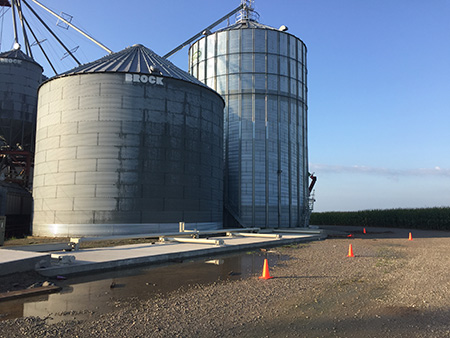 |
It also feels fantastic to be lucky enough to have time to get most of the irrigation equipment put away, drained and serviced for next year. As I mentioned earlier, we were able to catch some mid– and late–August rains to finish off both the corn and soybeans. It seems many years we are frantically getting this done after, or even during harvest, as the temperatures creep towards freezing. I dislike working on irrigation and pulling pipe when its 85 degrees, but I hate doing it even more when it's 40 degrees and raining.
This month I'm also getting GPS hardware and displays in the proper tractors and combines. It seems I spend a day just doing updates before every spring and fall. We are also getting our soil sampling gear ready; more to come on this I'm sure. The local shipping company loves us this time of year. Every fall they find it hilarious and wonderful that we overnight dirt!
Our family has been fortunate to have the time to go camping a few times this summer. Our children, Madalyn (7) and Benjamin (3), have seem to really taken a liking to camping (see photo). My camping as a kid was a hotel, but surprisingly I've taken a liking to it as well. It's important to slow down every now and then to be reminded what is truly important. For me, that's hot dogs by a campfire with your family.
 |
Summer is roaring by at a rapid pace! We have been busy with irrigation, spraying Priaxor on corn and soybeans, and all of those fun projects that must be done before harvest. One thing we are adding to our operation is a platform scale to run all of our incoming grain across. We have always had an axle scale, but that just isn't fast enough anymore, and it was in need of too much repair. But what really makes all of this possible? I certainly couldn't do everything that must be done every year for spring planting, summer irrigation and fall harvest! Where do we find all of the time?
Employees are our biggest asset! I don't want to use the term "for granted" because that certainly is not the case here. But I think sometimes it can be easy to forget how critical they really are. I feel it's important to make an effort to make sure they always know how much they are appreciated, and a paycheck every Friday isn't enough! We do this is many ways in our operation. I feel one of the best ways to show appreciation to one's workforce is to HEAR their ideas, not just listen, but hear them.
We all like things done our way to some extent, and as much as my ego would love to think I have all of the best solutions for any particular situation, I don't! Please don't tell my ego this.
I spend a lot of time during irrigation season with one key employee, Carl Hallett. Most mornings we take off in a pickup with a shovel in the back and head to each irrigation pivot to dig and decide what fields are a priority for that day. Believe it or not, we don't always agree!! But, looking back, he often has the better plan! So even though we may have different ideas on the plan for the day, it's important I hear what he is saying. Often, I decide we are going to run the irrigation plan that Carl has decided on for the day.
Our team includes many other critical employees. Jim Erway has been with us for over 30 years. Jim can fix anything you throw at him! He can do this often without even getting parts from town (very handy on the weekends!!). We sometimes call him MacGyver for his ability to scrounge up parts from around the farm to at least get us back going in the middle of planting or harvest!!
We then have Willie Bill and Chris Bill (yes Bill is their last name, I promise you). This is a father and son team that runs the field cultivators in the spring and does all of the fall tillage work. Not to mention the thousands of jobs they do when we aren't in the fields. It's great to have a pair of employees that you don't have to worry about what kind of job they are doing, or how the seedbed is going to look when a planter pulls in behind them. We jokingly gave Willie, the father of the duo, the title of "Head of the Grounds Department." You have never seen anyone so concerned with making sure every blade of grass in the yard is mowed with precision! Not one weed is visible in the farm lot or yard!! It's not often you can find people that will take that much pride in their work! Well, we found four!!!
Thanks, Team!!!
I'm happy to report that this blog entry is NOT another planting progress report! In fact, it seems like we went from a slow, wet planting season, to an almost perfect side–dressing window, right into a really hot and dry June. My wife's grandfather and father had the foresight to actually document and record the daily heat units and rainfall on our farm every day for the past 40–plus years. I'm thankful for those historic records, because they prove valuable when we want to compare this year to prior seasons. Despite getting those frequent small rains in May that held up our planting, we actually ended up with below–average rainfall for May at our farm. We had a total of 1.9 inches in May; that is 1.6 inches below our 40–year average. If we finish out June without any additional rainfall, our farm will have received only 2.6 inches, that's 1.9 inches below our 40–year average. We have also had four days above 90 degrees already!
We side–dress a second shot of N on our corn with ammonia, with our irrigated corn getting a third shot right before VT, ideally. We started irrigating corn on June 13! This is the first year we have ever gone so quickly to irrigating after getting our ammonia applied. In fact, this is the earliest I can ever remember starting our irrigation. This week we are spraying our soybeans with herbicide and staying on top of the irrigation. Despite receiving seven–tenths of an inch of rainfall on June 22, we continue to irrigate our corn. Overall, especially if you were considering weather data in this little "backyard" of the country, the crops look relatively good!
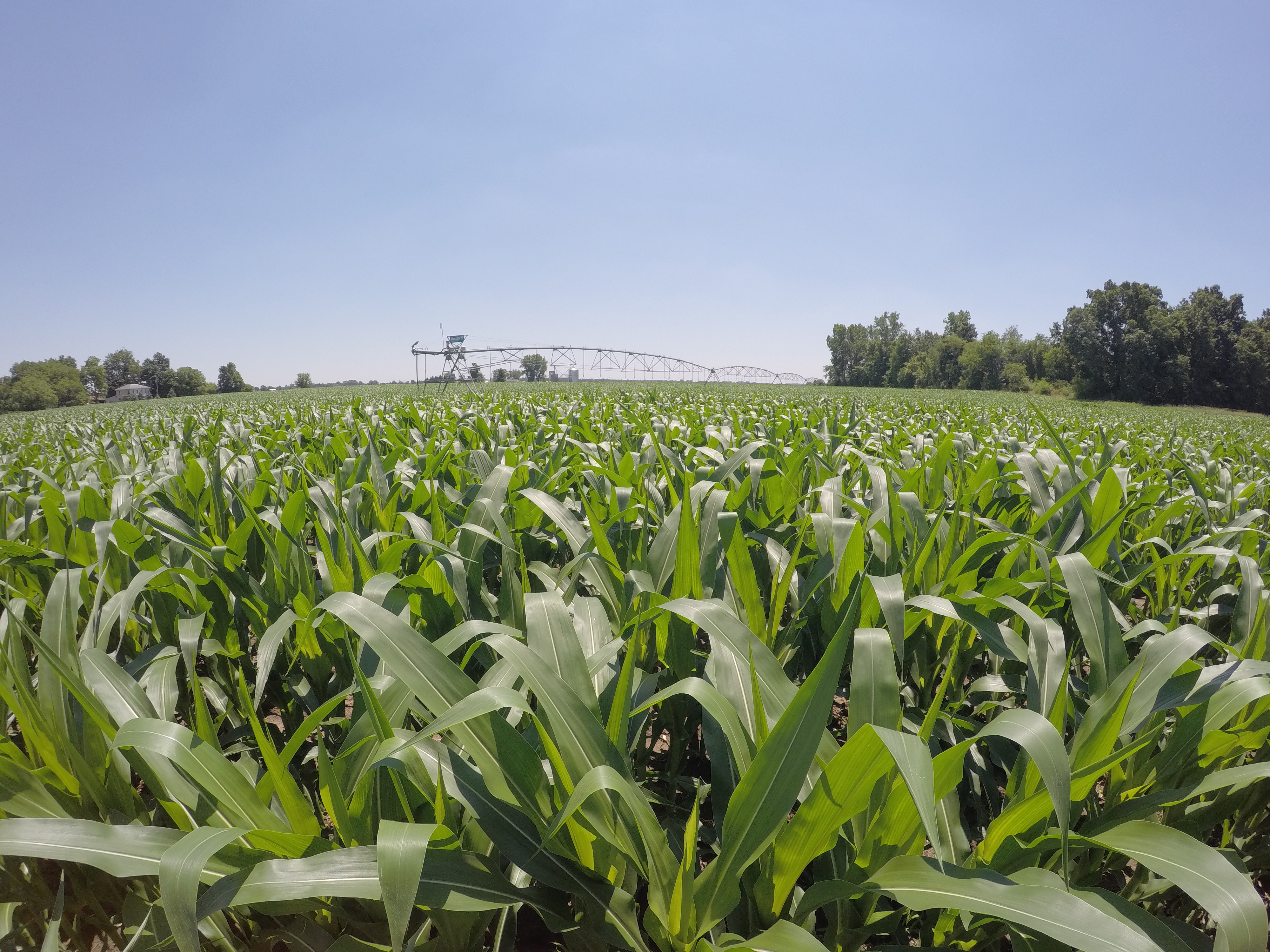 |
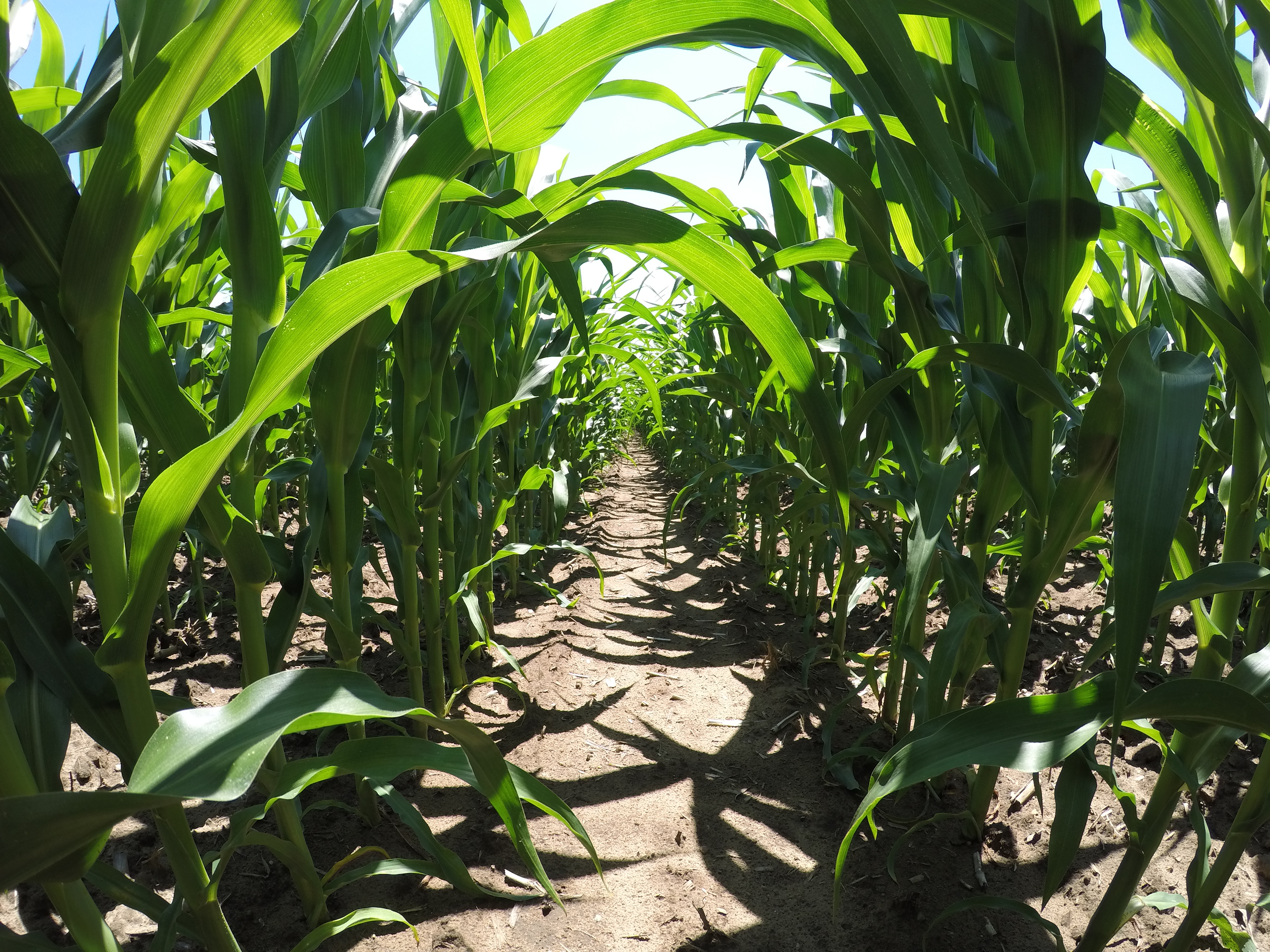 |
This irrigated field of 102–day corn was planted April 25 at a population of 33,000. On June 24, when these photos were taken, this field was at the V8 to V10 growth stage.
I said in my third blog: "I don't mind getting a slight rain delay after the start of a season (as long as it stays short!)." Well, that didn't happen!!!
For the week ending May 15, the NASS has Michigan's corn planting at 34%, compared to 71% planted last year. I wouldn't be surprised if much of southern Michigan is even further behind than that. Specifically, around Southeast Michigan, any ground that isn't considered "light" or "sandy" (CEC below 8 to 10) hasn't had a tractor on it all spring. Any "heavier" ground around here has yet to be dry enough for any fieldwork. With that being said, I am writing this month's blog early because it appears, at least for now, that we may get a good seven– or eight–day break in the weather.
We haven't had an above–average amount of rain; it has been the timing of the rain events. Everything starts drying up, we get within a day or two of being able to plant, and then we catch yet another rain. It has rained eight out of 17 days in the month of May.
But enough about what we can't change; we certainly aren't the only ones with planting progress issues. What can we change? The hardest thing to change is sometimes the simplest —our attitudes. I have yet to see getting frustrated and angry at the weather change the forecast. If this does happen to work, please send me an e–mail immediately to let me know your secret, as I will quickly allow myself to throw a temper tantrum that actually does something.
If the weather won't cooperate to allow us to get all of our corn in soon, we may have to move some corn acres to lighter ground —which was originally intended for soybeans —as all the corn we have left to plant is on "heavier" ground. Right now our priority is to get the rest of the corn planted that is under irrigation. We prefer to keep irrigated fields to corn if we can. We have had much better luck with irrigated corn than we have had with irrigated soybeans.
I never thought two of my blog entries would be talking about our planting progress. Let's hope this is the LAST!
Well, like so many farmers across the Corn Belt and beyond, we have our corn planters going. We are in a slight holding pattern after receiving a quarter inch of rain on April 21, but I can't complain. I don't mind getting a slight rain delay after the start of a season (as long as it stays short!). It lets us work out any bugs we may have found with equipment or systems in place. Luckily, we have a little irrigated sand that we can always start early on. More on irrigation to come, trust me.
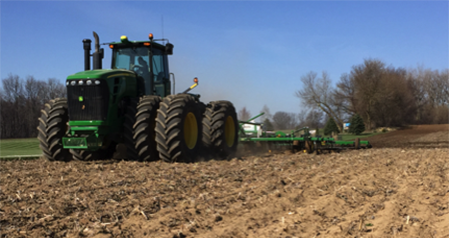 |
One of the most rewarding aspects of this life in agriculture is the ability to spend time with family, even when I am very busy. No matter how tough of a day I may be having, it all goes away when my wife pulls into the field with our two children. When one of them jumps in the cab with me, everything is immediately fine.
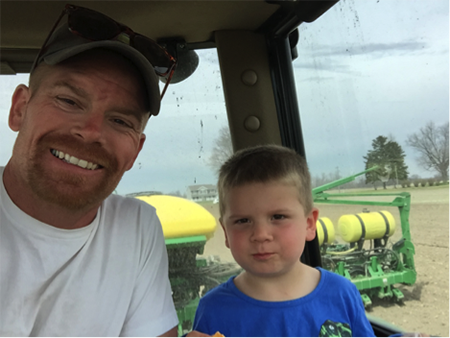 |
My son can't get enough of it. He plays with toy tractors all year, and is fascinated by it all. I think he gets more excited than I do when the equipment comes out of the machine shed. His brain runs rapidly trying to figure everything out that is going on with the equipment. Now if I could just get him to stop grabbing the steering wheel and disengaging the auto–steer!
My daughter loves hopping up with dad, but as you can see she might not be quite as fascinated by the whole process like her brother. She has fallen asleep every time she has ridden, since her birth, EVERY SINGLE TIME. She gets that from her mother. My wife can't make it two rounds before falling asleep, and she was the same way as a child. Go figure! But my daughter will never turn down an opportunity to go make some rounds with Dad. What else could a father ask for?
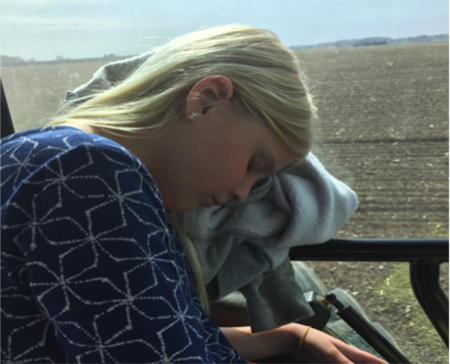 |
"Farming is in my blood!" We hear this proud statement in our industry so often. The very nature of this occupation, business and lifestyle proves this true. "The Farm" was passed down from generation to generation…. But what if technically it's not in your blood? That's my case. I've always said, "Farming is in my blood now." I married into this crazy world, and love it. I do feel farming is in my blood now, or at least I know for certain my blood is in farming. More specifically, my blood is quite literally sprinkled here and there on the corn planter, thanks to slipped wrenches and busted heads on the frame.
We just wrapped up our annual spring–servicing of the corn planters. I always feel like we aren't ready for spring, no matter how "ahead" of schedule we are (if that is even possible!). We do keep an eye on a long–term weather forecasting firm's predictions, as I'm sure many of you do. If they are right, our planting season (Southwest Michigan) will be late at best. Cold temperatures and above–average rainfall are predicated for most of April. We have started planting corn as early as April 6, but often we are getting into "full swing" around mid–April.
We are getting our seed strategically placed and organized in the seed barn and will soon run our soybean seed through our seed treater. I do have some seed deliveries to make as my wife, Lisa, and I recently took on a Great Lakes Hybrids dealership. This seemed to make perfect sense with her return to the farm in the beginning of 2015, and our heavy use of their products already in place.
The side–dressing rigs are fit to go, and the ammonia tanks are full. We start as soon as we can with side–dressing our nitrogen (sooner than some might think is necessary). But some years, by the time we were finishing up, we were only a good 2–inch to 3–inch rain from being too late.
If the long–term forecast is correct, when our planting window hits we have to be prepared to hit it hard. To do that, we must have all of our ducks in a row. Which reminds me, maybe I should check things over on the planter just one more time. I'll have my 6–year–old daughter, Madalyn, and my 3 year–old son, Benjamin, help. After all, they both really do have "farming in their blood!"
I get asked all the time from my non–farmer friends. "You must love winter, because there isn't anything to do on the farm, right?" Well, we all know that statement cannot be more untrue. Over the winter months I spend a large amount of my time reviewing data from the previous year and tweaking fertilizer rates. Yes, it IS as monotonous as it sounds, but it's undoubtedly necessary! If we don't measure quantitative data (not just yield maps), how can I possibly do something different, and subsequently better, next year? Isn't there a saying about insanity—doing the same thing over and over again and expecting different results?
When analyzing yield maps, I find myself obsessing over the poorer performing areas of a field. I become much more captivated about those low–yielding areas than the eye–popping, high–performance stretches that are so fun to harvest and watch with the yield monitor. It is gratifying to literally see the fruits of our labor, watching the yield monitor in those higher–yielding acres. But I must dissect the embarrassing, not so good—and hopefully far away from the road—low–yielding parts of our fields.
So, for us, how do we get the most accurate data? On our farm, we pulled over 700 soil samples this past fall alone. Then we added in planting and spraying data, hybrid test plots, and other strip trials of nutrients and fungicides. It is a lot to process, but a lot can be gained from combing through data.
For example, this past year we did a fungicide strip test on an irrigated field of corn. Quite frankly, I didn't think we would see enough yield increase to justify the application. Adding to my skepticism, we had done some work with fungicides in the past without much response. I, however, was dead wrong; we did see a response. Our data illustrated a positive response with BASF's Priaxor. The average yield response was +20.7 bushels per acre. Needless to say, we will continue increasing our use of this product, while not forgetting to verify and measure its response every year.
So to my non–farmer friends, that is just part of what a farmer does in the winter; plus there is that machinery maintenance thing, too…